Paying attention to what your customers are saying is the best thing you can do for your business. Regardless of the nature of the communication, it’s all valuable.
That said, there are many different types of customer feedback.
Some are obvious, like feature requests. Others are more subtle, like questions about your product. Sometimes you reach out to get certain types of customer feedback. Sometimes, you don’t, and customers just leave their feedback.
Is one kind of feedback more important than another? And how should you address different types of feedback?
In this post we’ll be talking about the different types of customer feedback and what to do with them.
The two main types of customer feedback:
- Feedback customers give you without you asking (like bug reports)
- Feedback you reach out for (like customer surveys)
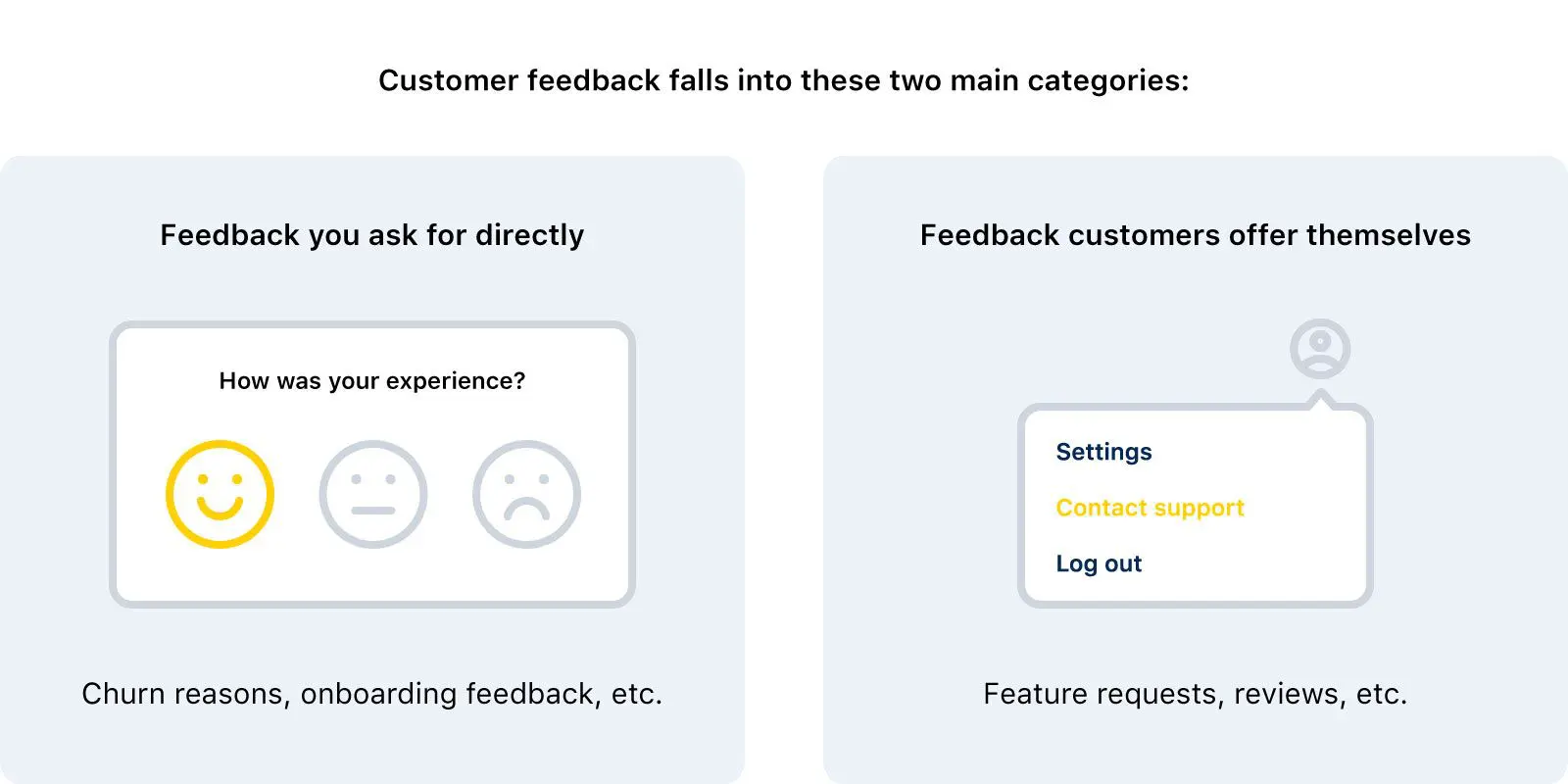
At a glance, it might seem like feedback you ask for is more important and actionable.
But there’s often a lot of value in the feedback you get without asking for it. This includes forms of communication that you might not be paying as much attention to.
Customer feedback type #1: feedback you get without asking
These are the types of customer feedback you don’t reach out for yourself:
- Feature requests
- Bug reports
- Questions
- Reviews on public sites
- Praise
- Customer complaints

Let’s go through and discuss each of these.
Feature requests
Feature requests are ideas for how you can improve your product or service. They usually come from a pain point on the customers’ side — they want to do something, but can’t.
So, they request a new feature.
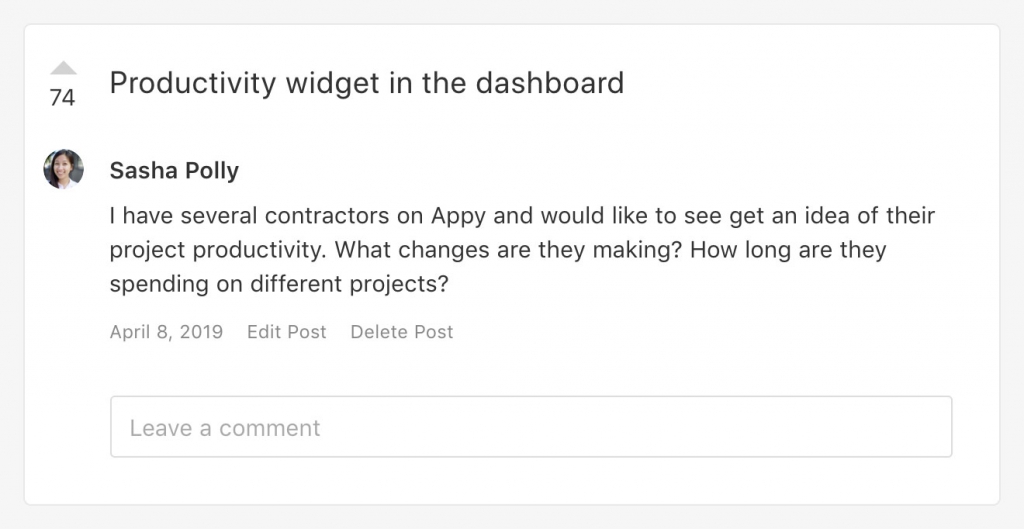
Why this type of customer feedback matters
Implementing features that your customers want adds value. The more value you deliver, the more successful your business will become.
So, feedback requests are an incredibly important thing to track and monitor.
Not all feature requests will make sense for your business. But, the reasonable ones are a goldmine for building your future roadmap. You should keep track of every feature request you get, and see which fit into your roadmap.
You can use Canny to easily track and prioritize customer feedback. We’ve also written about how to prioritize customer feedback by using a roadmap – check it out.
Feature requests are some of the most valuable types of feedback that customers can give you. They give you a clear understanding of what your customers really want. Tracking feature requests keeps your roadmap organized and prioritized for more value.
Bug reports
Bugs are problems that your customers run into while using your product. They can vary from small UI issues to your entire site being down.
A buggy product will almost certainly lead to churn. And, churn is the biggest enemy of every software business. If your product doesn’t work, customers can’t access its value. If they can’t access the value, they’ll leave.
The first thing to do with a bug report is to confirm it exists:
- Ask how the user ran into the issue
- See if you can you reproduce it yourself
If you can reproduce it, consider whether you’ll fix the bug:
- Who is this affecting? All customers, or a select few?
- How severe is the bug? Are certain features unusable?
- How much time/money would it cost to fix it?
If a bug is easy to fix, you should squish it. This shows your customers that you care about their experience. It shows that you take their feedback seriously.
Try to keep ahead of bug reports by using a notification service for issues. We use Sentry for this.
Why this type of customer feedback matters
Bug reports show what is and isn’t working. But, they’re also insight into the ways your customers are using your product.
It’s good practice to consider what’s causing the issue and how you can avoid it in the future. For example, there might be a unit test you can write to ensure the problem never happens again.
This type of customer feedback comes directly from your engaged user base. Sure, it shows what you need to fix. But, it also shows how your customers are using your tool. And, you can show that you’re invested in giving customers a good experience with your product. Being proactive about technical issues drives customer satisfaction and loyalty.
Questions
At every step of the customer journey, people will have questions:
- What does your product do?
- How much does it cost?
- How do I set it up?
…and so on.
Your landing page, documentation, or product itself should answer most of these questions.
But, there will still be times when people can’t find the answer they’re looking for. That’s when they reach out to you.
Questions aren’t “intended” to be feedback. But, if you think about it, in a way, they are.
Why this type of customer feedback matters
Receiving a question means you could make something clearer. If everything was clear, your customer wouldn’t have a question to begin with.
If you start hearing the same question over and over, it’s worth answering. This might be within your product, in a help center article, or with an FAQs page. It’ll save time for you and your customers — win-win.
Reviews on public sites
Review sites give your users the chance to talk about your company indirectly. Unfortunately, they often do this when they’re already mad about something.
You have no control over this. Unless it’s untrue or inappropriate, everyone has the right to express an opinion.
They’re not always bad, though:
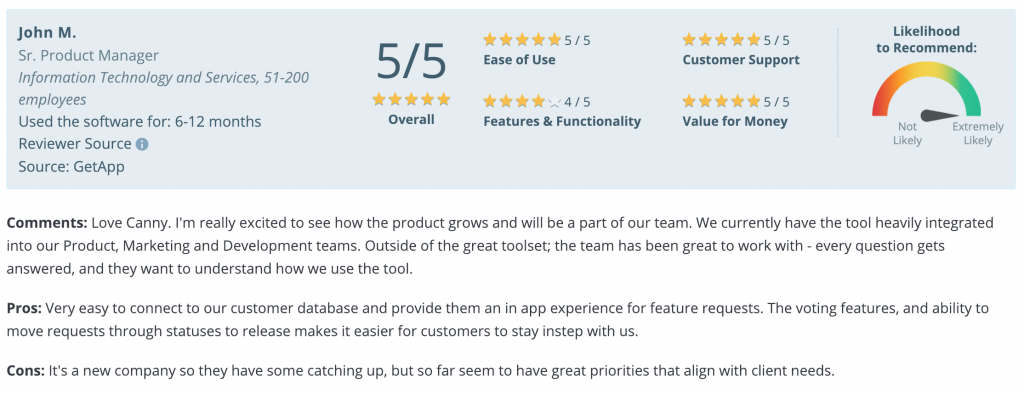
Why this type of customer feedback matters
It’s important to keep an eye on what users are saying about your product.
You can either browse them by hand or set up mention notifications.
Monitoring this type of customer feedback matters for a few reasons. At a basic level, it shows what your customers like and don’t like. But beyond that, it gives you a chance to publicly address concerns and ask for more input.
Always record the feedback and respond with a thank you, whether it’s negative or positive. With positive reviews, you can always ask if there’s anything at all they would like changed.
With negative ones, ask to discuss it further. You may be able to resolve whatever triggered the bad review. Brownie points if you go back and let whoever complained know when you’ve fixed the issues.
Praise
This is when a customer tells you about a great experience they had with your company.
Praise is a good sign. Someone took the time to say nice things about your company. That means they must appreciate what you do a lot.

Why this type of customer feedback matters
A satisfied customer who goes out of their way to offer unsolicited praise might be willing to share more feedback. This can help you grow and improve.
Praise is nice to receive, but don’t let yourself get lazy. You should still check whether there’s any constructive feedback you can get out of it.
With every nice comment, ask if there’s anything at all you could still improve on. You can also ask for help with getting the word out:
- See if they’ll leave a review on GetApp, G2Crowd, or Capterra
- Ask for a testimonial for social proof
- See if they’d be willing to be featured as a case study on your website
- Ask if they know anyone who might want to use your product
Don’t be pushy about this. You don’t want to ruin the good impression they have of you by being annoying.
Customer complaints
While it’s always nice to be praised, there’s value in negative feedback too. Praise usually comes from happy customers that aren’t having any problems. That’s great, but on its own, doesn’t give you much direction to improve.
An unhappy customer can highlight areas you can improve. Train your customer support team to dig in and uncover the actionable feedback behind complaints.
That might show up as feature requests, bug reports, or problems with your customer experience.
Whatever it is, it’s gold.
It gives you direction on how you can improve and gives you an opportunity to keep the client happy. Acting on their feedback with future product updates shows you care and can boost customer retention.
Customer feedback type #2: Feedback you reach out for
These are the types of customer feedback you specifically ask for:
- NPS responses
- CSAT surveys
- Customer effort scores
- Ratings (in-app)
- Sales objections
- Churn reasons
- Customer surveys
- Onboarding feedback
- Feedback after a support interaction
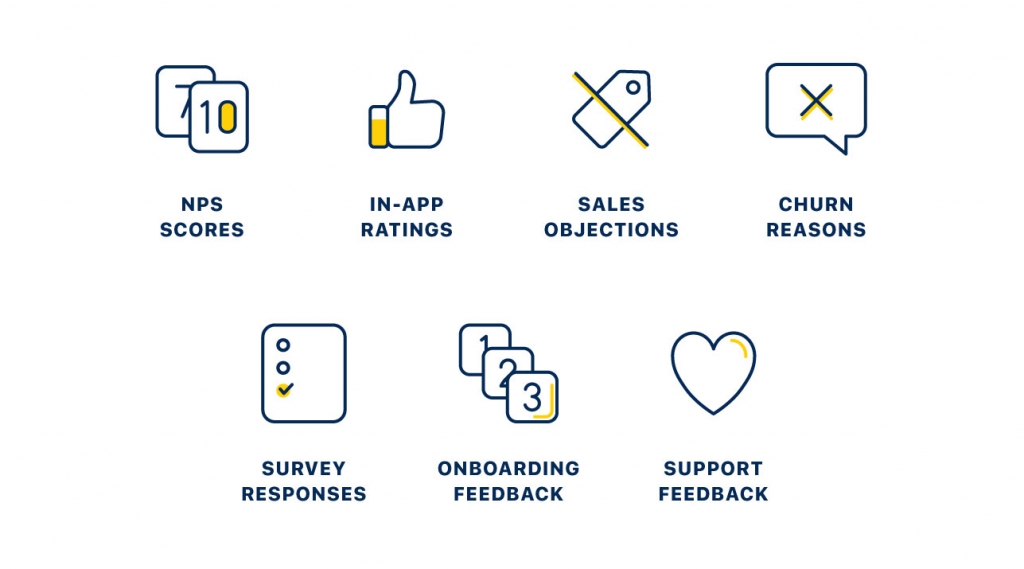
NPS responses
The NPS (net promoter score) is a popular way to measure customer satisfaction and loyalty.
The NPS survey is simple:
- On a scale of 1-10, how likely are you to recommend us to a friend or colleague?
- Why did you choose that score?

Customers are then split up into three categories:
Promoters (9-10)
These are your most loyal customers. They’re least likely to churn, and most likely to speak well about your brand to others.
There are many ways you can use this to your advantage:
- See if they’re willing to leave reviews on GetApp, G2Crowd, Capterra, or similar.
- Ask them for a testimonial or case study that you can put on your website and social media
- Point them to a customer referral program if you have one
And, most importantly, express your gratitude loud and clear.
Passives (7-8)
Passives are having an “okay” experience with your product. They aren’t about to churn, but they aren’t loyal, either. Promotion-wise, they aren’t likely to speak about your brand to other people at all.
Figure out how you can turn them into promoters instead of passives. Read why they chose a passive score, and see if there are any quick wins to be had.
If they didn’t give an explanation, reach out and ask what you could do to provide them with a stellar experience. There might be some ideas for improvement there!
Detractors (1-6)
Detractors are the most urgent customers to deal with. They’re most likely to churn and say negative things about your brand.
Figure out how you can turn their negative experience into a positive one by reaching out. Why did they choose that score, and what can you do to fix it?
CSAT Surveys
A customer satisfaction survey (CSAT) is a relatively simple way of gaging how satisfied your customers are.
To do this, ask one simple question — how satisfied are you with our product or service?
Customers answer on a scale, usually from 1 to 5. 1 being very unsatisfied, and 5 being extremely satisfied.
Once you’ve collected survey results, you count how many results are positive. Then, you just divide that number by the total number of responses.
For example, say you asked 100 customers how satisfied you were. 75 answer with a 4 or 5 on your scale. Your calculation would look like this:
75 positives / 100 responses = 0.75
That works out to a 75% satisfaction score.
The CSAT survey is an easy-to-use method and can help you track satisfaction at different points in your customer journey.
In terms of follow-up on these surveys — you can generally follow the same advice we gave for NPS.
Customer Effort Score
Customer effort score (CES) is a customer feedback survey that looks at how easy it is for customers to accomplish their goals in your product. You could send a CES survey to measure the ease of any aspect of your business:
- How easy was it to sign up?
- How easy was it to set up your account?
- How easy was it to contact customer support?
Those are just a few examples. You likely have some unique to your business you’d like to explore.
You ask customers to answer your questions on a likert scale from 1 to 7, 1 being strongly disagree, and 7 being strongly agree.
Then, you just add up up the total value of all responses and divide it by the total number of responses.
For example, let’s say you ask 100 customers to answer a question. The average response is 5. That means the sum of responses is 500.
So, your calculation would look like this:
500 / 100 = 5
That would be a good CES score. Anything equal to or greater than 5 is good. Anything less, is considered poor.
CES lets you gauge the ease of use of anything you want. This can help you identify features that are difficult to use. Your product development could then focus on making them easier to use.
Ratings (in-app)
In-app ratings are another quick easy way to ask for feedback.
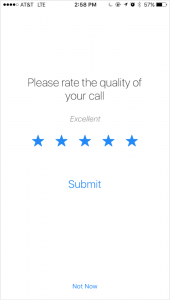
You can trigger a rating action at any time, or after the user completes a specific action. Like NPS, you should always ask for an extra comment explaining the rating.
Sales objections
This is what a prospect tells you when they decide not to buy your product or service. If one customer has a sales objection, it’s likely that others will have the same one.
That’s why it’s important to ask, “Why not?”
Here are some typical objections you might hear:
- Pricing: “It’s too expensive. We’re going with X instead.”
- Product: “It’s missing a critical feature or integration. We’re going with X instead.”
- Demand: “We don’t need it right now, we’re going to hold off.”
“Dealbreakers” are very similar to sales objections. This is when a lead tells you they want to buy, but need feature X for it.
Hearing a lot of the same sales objections or dealbreakers? You might want to consider building the feature or making the change.
You might consider product pricing experiments based on this feedback. It could help you find a price point suitable to your prospects.
These are all valid reasons for no sale. And, not every objection needs addressing. But, you should always track these objections and keep a list of them. Over time, you’ll start to see patterns and easy ways to stop losing customers.
Churn reasons
This is what a customer tells you when they’ve decided to stop using your product. It’s like sales objections—the only difference is they’re already your customer.
Here are some common reasons that customers churn:
- Engagement: “We aren’t using it.”‘
- Shutting Down: “Our company ran out of money. We’re shutting down.”
- Competition: “We’re going to use X instead.”
It’s important that you find out why a customer decided to cancel. Don’t let them leave without telling you why.
At Canny, we have people message us on Intercom to cancel their subscription. This way, we get to have a (brief) conversation with everyone who cancels.

As long as we cancel their subscription immediately, they’re generally happy to elaborate. It’s also a nice way to end the customer relationship.
Collecting this type of feedback eliminates guesswork. You don’t have to wonder why a customer decided to stop using your product.
Keep track of reasons why people churn, and its consequences to your bottom line in a spreadsheet or a feedback management system. Soon, you’ll start noticing common reasons for cancelling, and eliminate them.
Customer surveys
Customer surveys are generally sent via email to existing customers. It’s a regular feedback request (usually done once or twice a year, depending on the company).
Surveying customers is one of the more obvious ways of collecting feedback. The purpose of a survey is to ask questions to assess customer satisfaction.
The downside? It’s a bigger ask. Surveys are more labor-heavy for customers than other feedback types. Especially if you compare them to something like an NPS survey, which takes a few seconds.
This means that need to format the surveys carefully:
- Ask the right questions for constructive answers
- Appreciate the effort
- Always respond with an option to talk further
As for formatting customer surveys, start with this SurveyMonkey article. It covers which customer survey questions are the most (and least) productive.
Onboarding feedback
Onboarding is one of the most crucial stages of your customers’ lifecycle.
It’s their first impression with you. They will definitely have questions, as well as valuable feedback.
During onboarding, make sure your customers:
- Are supported throughout the process (ask them if they need help before they have to reach out)
- Have the option to easily give initial feedback
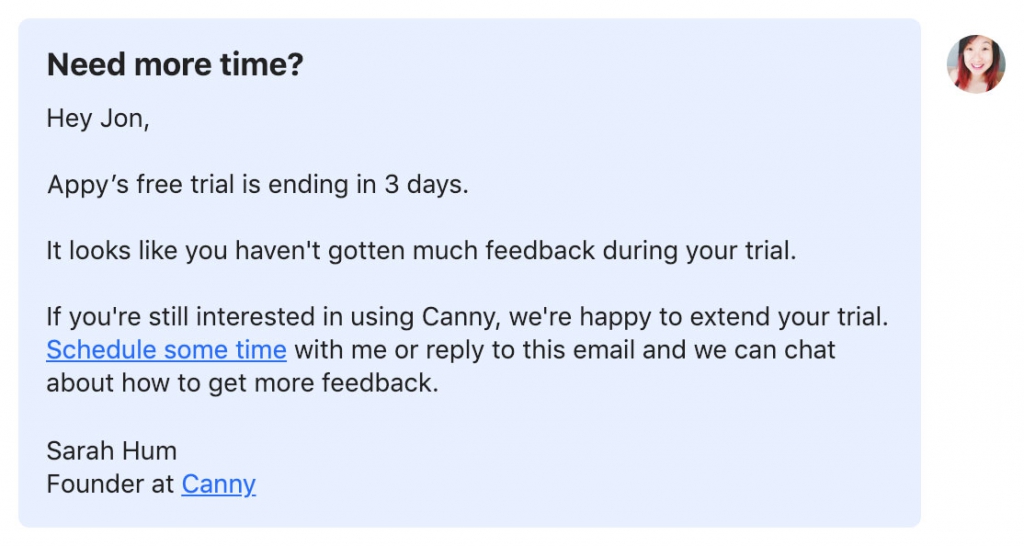
Send regular (but not too regular) messages during the trial/onboarding stage:
- A getting started guide
- Not a lot of activity—why?
- Didn’t set up—why?
- Not extending trial or becoming a customer after onboarding—why?
Feedback during onboarding is valuable because it’s very raw. The customers who are just getting to know your product have no bias.
Record all valuable feedback from onboarding customers, and use it to make the experience smoother.
Feedback after a support interaction
Some companies choose to add the option to rate a support interaction after it happens.
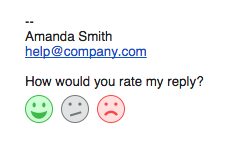
This feedback is low-effort for your customer, but it still gives you an idea about how you’re doing.
This feedback is more related to your support interactions than your customers’ experience with the product. But, it’ll still give you valuable insight into how you can improve.
Once you have enough data, you can start calculating your customer satisfaction score.
Takeaway: Collecting many different types of customer feedback is valuable
Many companies treat customer service and feedback like a cost. Cost is generally something you should try and minimize.
Don’t be one of those companies.
Feedback is an opportunity and a gift. It’ll help you provide value and improve your business from every angle.
Your customer is taking time out of their busy day to tell you how you’re doing, and how you can do better. You should appreciate and encourage it, not disregard it.
We’ve gone into more detail on how to get feedback – check it out. Even if you’re an early-stage business and don’t yet have a super-engaged user base, collecting feedback is still extremely valuable. And, if you’re looking for a way to keep track of multiple types of feedback from different sources, you can try Canny’s free customer feedback tools.
Which types of customer feedback have been most valuable for your business? Leave us a comment and let us know, or connect with us on Twitter .




Very insightful article, thank you! I am one of a group in training for a position in CX research and learning so much!